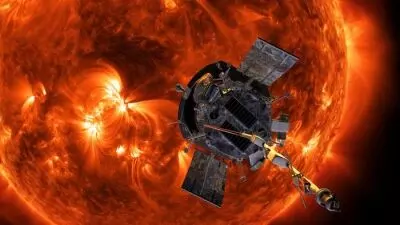
Source of solar wind detected by NASA's Sun touching probe
text_fieldsWashington: According to a new study, NASA's Parker Solar Probe has flown close enough to the sun to detect the fine structure of the solar wind close to where it is formed at the sun's surface. This has revealed characteristics that are normally lost as the wind departs the corona as a uniform stream of charged particles.
The Parker Solar Probe, which was launched in 2018, is intended to study how the charged particles of the solar wind—protons, electrons, and heavier ions, primarily helium nuclei—are accelerated to escape the sun's gravity as well as how the wind is generated near the photosphere, where it is turbulent.
The sun-kissing probe also aimed to resolve two conflicting explanations for the origin of the high-energy particles that comprise the solar wind: magnetic reconnection or acceleration by plasma or Alfven waves.
Understanding how and where the solar wind originates will help predict solar storms that, while producing beautiful auroras on Earth, can also wreak havoc with satellites and the electrical grid.
To do this, the sun-kissing probe had to get closer than 25 to 30 solar radii, that is, closer than about 13 million miles.
"Once you get below that altitude, 25 or 30 solar radii or so, there's a lot less evolution of the solar wind, and it's more structured -- you see more of the imprints of what was on the sun," said Stuart D. Bale, a professor of physics at the University of California-Berkeley.
In 2021, the Parker probes instruments recorded magnetic field switchbacks in the Alfven waves that seemed to be associated with the regions where the solar wind is generated.
By the time the probe reached about 12 solar radii from the surface of the sun -- 5.2 million miles -- the data were clear that the probe was passing through jets of material, rather than mere turbulence.
The researchers traced these jets back to the supergranulation cells in the photosphere, where magnetic fields bunch up and funnel into the sun, which they described as "like seeing jets of water emanating from a showerhead through the blast of water hitting you in the face".
"The big conclusion is that it's magnetic reconnection within these funnel structures that's providing the energy source of the fast solar wind," Bale said, in a paper to be published in the journal Nature.
The teams said the Parker probe won't be able to get any closer to the sun than about 8.8 solar radii above the surface -- about 4 million miles -- without frying its instruments.
Bale expects to solidify the team's conclusions with data from that altitude, as the sun is now entering solar maximum due to its magnetic field flip which occurs every 11 years and its activity will become much more chaotic, obscuring the processes the scientists are trying to view.
With inputs from IANS






